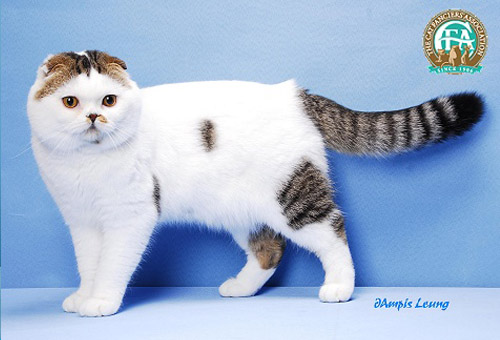

In 1961 a shepherd by the name of William Ross spotted the first known Scottish Fold cat at a farm near Coupar Angus in the Tayside Region of Scotland, Northwest of Dundee. Ross asked the owners if he could have one of the kittens, and proceeded to develop the breed from the original, Susie, a white barn cat. The unique thing about this cat was that her ears folded forward and downward on her head. The resulting look gave the impression of a “pixie”, “owl”, or “teddy bear” that has captured the hearts of many American cat fanciers and judges. The Scottish Fold was granted championship status by The Cat Fanciers’ Association (CFA) in 1978. Scottish Folds come in two types: folded ear and straight (normal) ear. The folded ear is produced by an incomplete dominant gene and is the result of a spontaneous mutation.
Scottish Fold kittens are born with straight ears. At about three to four weeks of age, their ears fold...or they don’t! It is usually around eleven to twelve weeks of age that the breeder can determine the quality (pet, breeder or show). Presently, only folded ear cats of Scottish lineage are permitted in the show ring, and naturally, every breeder wants to produce show cats. The straight ear progeny of Scottish Folds, nevertheless, are invaluable to the breeding program. Due to the rarity of the Fold, AND due to the fact that not every kitten born has folded ears, it is very hard for the supply to keep up with the demand. Scottish Folds are hardy cats, much like their barnyard ancestors. Their disposition matches their sweet expression. They have tiny voices and are not extremely vocal. They adore human companionship and display this in their own quiet way.
Scottish Folds adapt to almost any home situation and are as comfortable in a room full of noisy children and dogs as they are in a single person’s dwelling. They don’t usually panic at shows or in strange hotel rooms, and they adjust to other animals extremely well. When inspecting a Fold for purchase, be sure to determine the flexibility of the tail and check the feet and legs. There must be no hint of thickness or lack of mobility due to short, coarse legs or splayed toes. Determination of tail flexibility can be accomplished by moving your hand down the tail in a VERY GENTLE, slightly upward-arching movement. With proper flexibility, this arching movement can be made without discomfort to the cat. Again, when doing this PLEASE BE GENTLE! The Scottish Fold is an undemanding cat. A clean environment, proper nutrition, and generous doses of love are its only requirements.  Pictured: Third Best of Breed GC, DW DRAGONHILL WHITE OWL, Brown Mackerel Tabby & White Shorthair Scottish Fold Male Photo: © Ampis Leung Pricing on Scottish Folds usually depends on type, applicable markings and bloodlines distinguished by Grand Champion (GC), National Regional winning parentage (NW or RW) or of Distinguished Merit parentage (DM). The DM title is achieved by the dam (mother) having produced five CFA grand champion/premier (alter) or DM offspring, or sire (father) having produced fifteen CFA grand champion/premier or DM offspring.
Usually breeders make kittens available between twelve and sixteen weeks of age. After twelve weeks, kittens have had their basic inoculations and developed the physical and social stability needed for a new environment, showing, or being transported by air. Keeping such a rare treasure indoors, neutering or spaying and providing acceptable surfaces (e.g. scratching posts) for the natural behavior of scratching (CFA disapproves of declawing or tendonectomy surgery) are essential elements for maintaining a healthy, long and joyful life. There are CFA clubs devoted to the promotion, protection and preservation of the Scottish Fold breed. For more information, please send inquiries to CFA at cfa@cfa.org. Text: Kitty Angell Last Updated: Sunday, July 04, 2010
|
|||||||||||